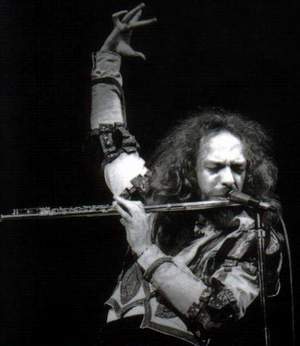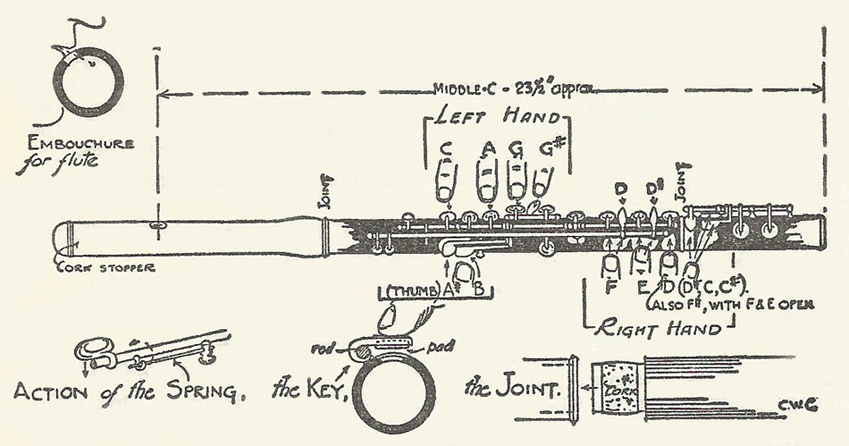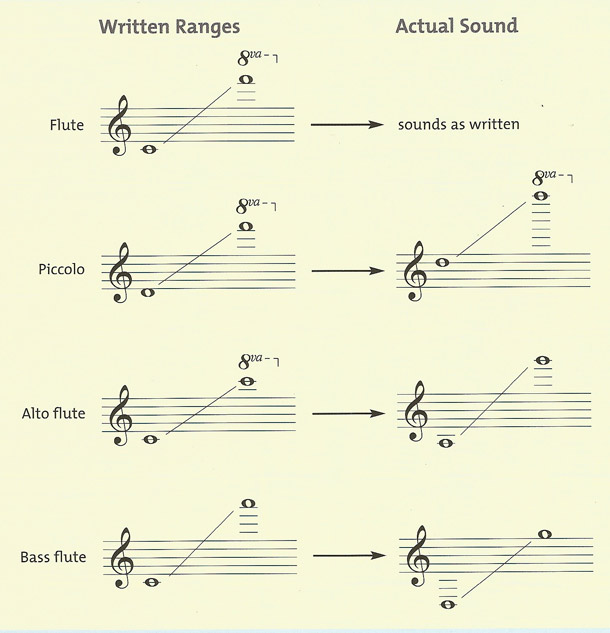flute

Figure 1. Ian Anderson of Jethro Tull playing the flute.

Figure 2. Anatomy of the Boehm flute.

Figure 3. Modern concert flute.

Figure 4. Comparison of the ranges of various kinds of flute and the piccolo. The concert flute's standard range is from B3 to D7 (forced up to F7).
The flute is one of the oldest wind instruments and, in its modern form, one of the standard woodwind instruments of the orchestra, also much used in folk and rock music. It originally had several varieties: one, called flûte à bec, later developed into the flageolet; another, which was sounded by means of a hole in the side like the modern flute; and a third, used by ancient Egyptians, in which the sound was produced by blowing into the open end of the tube.
Historical developments
The reedless flute (from the Latin flautus = 'breath' or 'blowing'), of wood or bone, has a venerable history. It is no etymological accident that the Latin word tibia means both 'flute' and 'shin-bone'. an end-blown variety (see end-blown flutes) dates from Paleolithic times (long flutes have been found in early Egyptian sites of before 3300 BC) and led ultimately to the recorder family, but the side-blown flute ('cross-flute', 'traverse flute', 'transverse flute') occurs at least as early as the ninth century BC in China and may have existed earlier still in central Asia (see transverse flutes).
After the Romans, the flute was forgotten until it re-emerged in Germany in the tenth century, having drifted across from Byzantium. It spread as a folk instrument, finally entering the orchestra in 1681 in Lully's ballet Triumph a'amour.
Cone-bore flute
The cone-bore flute consists of a tapered tube, in which the sound is produced by blowing with compressed lips into a large orifice near the top or wider end, which is stopped with a cork. Six holes in the lower end, to be covered by the first three fingers of both hands, serve to make the scale, supplemented by keys numbered from one to fourteen. The flute is what is called an octave-scaled instrument – i.e. by covering all the holes and lifting the fingers one by one in regular order, beginning at the bottom, the notes from D below the stave to C♯ are made; then, by repeating this process and blowing a little sharper into the mouth aperture, the same notes, an octave higher, are produced. Another octave can be produced by cross-fingering, the total compass being about three octaves. Two additional keys at the bottom of the tube, worked by means of levers by the little finger of the right hand, give the notes C♯ and C below the stave.
The faults of this flute are that, as the holes must be placed where the fingers can reach them, they are not always in the exact places to be perfectly in tune, and the notes are not equal in quality. To meet these defects the flute underwent more changes and improvements. The most important of these were the cylindrical bore and the system of fingering introduced by Theobald Boehm in 1832.
Boehm's flute
Theobald Boehm (1793–1881) was a goldsmith, flautist, and flute maker. His important innovation was the use of ring keys, in which a ring surrounding a finger hole also operated a second hole, allowing one finger to cover two or more holes simultaneously (Figure 2). Boehm also developed a clear relationship between the size and diameter of the flute and the size and placement of the finger holes, as well as changing from a conically bored to a cylindrically bore instrument. He arrived at his final design in 1847, after many years of experimentation. His improvements were universally adopted for the flute and applied also to the oboe.
The modern flute
The modern flute has three basic parts: a headjoint (containing the hole into which the player blows), the middle joint or body (containing the main keywork), and the foot joint (containing the keys for the right little finger). See Figure 3.
The lip plate and embouchure are set in the conical headjoint. If the embouchure is set on a little plateau it is known as a reform embouchure. This slight elevation facilitates attack, which makes it especially popular with beginners. The upper end of the headjoint is closed by the stopper, which is movable and enables slight adjustments to intonation.
The cylindrical body contains most of the tone holes and the keywork. Pulling apart the headjoint and body has the effect of a tuning slide: the overall tuning of the instrument can be lowered by about an eighth tone.
The footjoint, a short cylindrical piece of tubing at the lower end of the flute, contains the tone holes for the lowest notes. The C footjoint is standard; with this notes from Eb4 to C4 can be played. By replacing it with a B footjoint B3 becomes playable as well.
The modern orchestra or concert flute features the Boehm key mechanism and possesses either open or closed keys. On models with closed keys, all the keys have cups fitted with pads of felt and gut. These pads are the instrument's main physical weakness; they are very sensitive to changes in temperature and dryness and are quick to shrink, which means they no longer make the tone holes entirely air tight.
The open-keyed flute is also known as the French model or ring keyed flute. Five of the keys on this flute are perforated. The corresponding tone holes are therefore not covered by cups but by the flautist's fingertips, which enables more effective control of timbre. Many flautists prefer to perform contemporary works on the open flute because it is better suited to modern playing techniques such as glissandi and quarter tones.
The flute's timbre is greatly affected by the material of construction. Normally, flutes are made of nickel-silver or sterling silver, which gives a flexible, well-projected tone. Wooden flutes are much richer, with a very strong lower register, while gold flutes produce a beautifully mellow sound. Many players mix materials – for example using a wooden head joint and silver middle and foot joints.
Range of the modern flute
The standard concert flute is pitched in C and has a range of about three and a half octaves starting from middle C (C4). In most cases the flute's highest pitch is C7 or D7, however more experienced flautists are able to reach up to F7 (and in some cases C8). Modern flutes may have a longer foot joint (a B-foot), with an extra key to reach B3. See Figure 4.
The lowest octave is produced by altering the effective length of the tube by the action of keys closing finger-holes; the next octave similarly but with increased wind-pressure; the octave above that by a system of 'cross-fingering' too complicated for brief description. The quality of the lowest octave is rather thick and somewhat like that of the clarinet; that of the middle octave smooth and clear; that of the highest octave bright and penetrating. Agility is a characteristic of the instrument, shakes and some tremolos being easy and also rapid reiterations of notes.
Development of music for the flute
The first published works playable on the flute appeared during the 1690s, but other instruments were given as alternatives; the relative newcomer to art music was not yet accepted. The massive popularity of the flute began in 1702 with what is possibly the first publication to specify the flute without alternatives: Michel de la Barre's Piéces pour la flute traversiere avec la basse-continue.
The first flute 'concerti' are the seven Sonatas for flute and strings of 1725 by Alessandro Scarlatti, and the first concerti, so called, are Vivaldi's six of Op 10, published c. 1729-1730. The latter were, however, mostly if not completely arranged from chamber works, and it is doubtful whether Vivaldi did the arranging. The first symphonies to include flutes (two of them in two works) are Scarlatti's 12 Sinfonie di Concerti grosso, begun in 1715.
Perhaps the instrument's popularity is now in better proportion than it was during the flute-crazed eighteenth century, when flute sonatas and concerti were produced in floods. J. J. Quantz wrote 312 concerti for his employer, King Frederick the Great, and the good king himself, not satisfied with Quantz's sonata total of at least 204, wrote 120 of his own. But flute mania persists still: Henry Brant wrote his Angels and Devils (1931) for flute solo accompanied by an orchestra of three piccolos, five flutes and two alto flutes; and in 1970 the Hungarian Zsolt Durko composed a concerto for 12 flutes and orchestra.
The flute d'amour and the alto flute, pitched respectively a minor third and a fourth below the flute, both arose during the 18th century and have been used occasionally since then for special effects in the orchestra. A concerto for flute d'amour by J .M. Molter exists in the Karlsruhe Landesbibliothek (Mus Hs 307) and was composed possibly around 1750. The name 'bass flute' sometimes applied incorrectly to the alto flute, should be reserved for an instrument pitched an octave below the flute; it achieved a certain currency among Italian operatic composers early this century.


